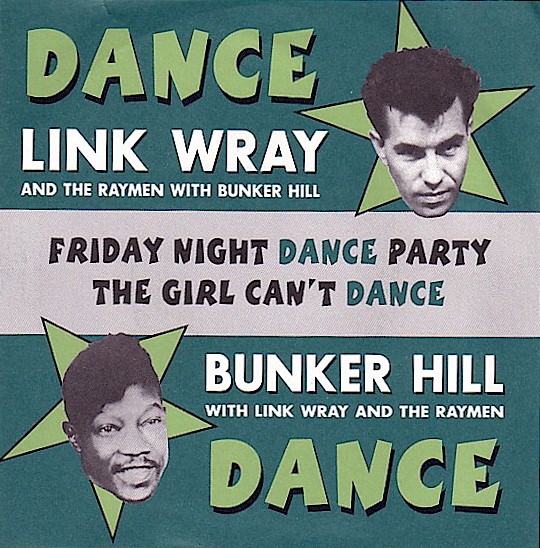The Strange Case of Bunker Hill
‘He took the Little Richard aesthetic one step further, about to its limit’
by David McGeeThe man Jim Jones cites as a seminal influence on his vocal style, and one who took “the Little Richard aesthetic one step further, about to its limit,” was born David Walker on May 5, 1941, but for a brief period of time—after leaving gospel giants the Mighty Clouds of Joy, shelving a boxing career that saw him achieve an 18-5 record as a heavyweight (with two draws) and become Archie Moore’s sparring partner—he blazed across the rock ‘n’ roll firmament for two years as Bunker Hill. In 1959, as David (or Dave) Walker, he joined the Mighty Clouds of Joy, one of the most enduring and influential groups in gospel history, following a tenure with the Los Angeles-based gospel group, The Sensational Wonders.
Exactly why David Walker decided to pursue secular fame remains unknown. What is certain is that he was discovered by one of his fellow D.C. natives, a fellow named Frederick Lincoln “Link” Wray, who had become and would remain the stuff of legend for his crunching, distorted, doom-laden, menacing, home-recorded guitar masterpieces, “Rumble” and “Jack the Ripper,” which gave birth to the power chord, and, generations hence, a whole other school of rock. Wray’s band the Raymen included his brother Vernon, whose D.C. home studio was the site for Walker’s first two secular sessions—at which he adopted the Bunker Hill monicker (again, for reasons unknown, except that he declined the suggestion that he call himself Four H Stamp; perhaps he had more affection for the American Revolution than for 4-H Clubs) so his gospel fans would not know he had gone over to the dark side. Link and the Raymen became his backing band on the D.C. circuit.
Bunker Hill's ‘Hide 'n Go Seek, parts 1 and 2,’ with Link Wray and the Raymen backing Bunker, was played in the record store scene in John Waters' Hairspray in which Ruth Brown, as Motormouth Mabel, grooved to the tune. Released on the Mala label, August 25, 1962, the single reached #33 on the Billboard pop chart, #27 on the R&B chart. It also gained the distinction of being banned by some radio stations for its suggestive lyrics. Joan Jett & the Blackhearts are among the bands that have covered it, none with the success of the original.In 1962 Vernon took the Bunker Hill tapes to Arthur Yale and Jack Fine of Mala Records, who proceeded to release three—the only three—Bunker Hill singles over the next two years, starting with Walker/Hill’s self-penned “Hide ‘n Go Seek” (which was issued in two parts on the single) and “Red Riding Hood and the Wolf.” Only on the B side of “Little Red Riding Hood and the Wolf,” in a song called “Nobody Knows,” based on the traditional spiritual number “Nobody Knows the Trouble I’ve Seen” and boasting a serene pop-inflected arrangement, did Bunker Hill ever tone it down. Otherwise, he adopted a pitiless scorched earth policy in attacking his material, and it’s a tossup as to whether he was more lethal on “Hide ‘n Go Seek” or on “The Girl Can’t Dance,” although he was certainly more wild-eyed and frenzied on the latter, it being the song that still takes Jim Jones’s breath away.
'Friday Night Dance Party,' Bunker Hill, backed by Link Wray and the Raymen. This was the A side of a 1963 Mala single, but did not chart.
Although Walker seemed to think he had shielded his identity by adopting the Bunker Hill pseudonym, his partners in the Mighty Clouds always knew what he was up to. In an interview with Soul Express magazine in March 2005, group member Joe Ligon said the Clouds “begged him not to go. He did come back, when his career started going downhill. He had one big record, but it just didn't fit his lifestyle. David Walker was a dynamic lead singer, When he and I sang together, I never had to sing uptempo songs. He sang all the fast songs. David and I were the lead singers. When the Clouds really began to come into our own as a group, David was leaving again at that time. I would say he left before the 1960s ended."
'The Girl Can't Dance,' Bunker Hill, backed by Link Wray and the Raymen, in, arguably, his most incendiary performance.
Although he would periodically return to the Mighty Clouds of Joy, and it was generally understood that he did return to church music for good, he never recorded again, and his fate is purely a matter of conjecture today. Finnish musician/historian Pete Hoppula (http://www.wangdangdula.com/), who has thoroughly researched Walker’s story, says “it seems very probable that he passed away in Houston, Texas, in the late 1980s, but no one has been able to confirm this yet. Until someone does, I’m going to keep my hopes alive that he’s still out there somewhere—just keeping his mouth shut and trying desperately to hide his sinful rock ‘n’ roll past.”
'Little Red Riding Hood & the Wolf,' a different take on the old story by Bunker Hill, backed by Link Wray and the Raymen. Mala single #457, it did not chart. Its B side, 'Nobody Knows,' is a lovely pop ballad with a gospel-influenced backing chorus, based on the traditional spiritual, 'Nobody Knows the Trouble I've Seen.'
Founder/Publisher/Editor: David McGee
Contributing Editors: Billy Altman, Laura Fissinger, Christopher Hill, Derk Richardson
Logo Design: John Mendelsohn (www.johnmendelsohn.com)
Website Design: Kieran McGee (www.kieranmcgee.com)
Staff Photographers: Audrey Harrod (Louisville, KY; www.flickr.com/audreyharrod), Alicia Zappier (New York)
E-mail: thebluegrassspecial@gmail.com
Mailing Address: David McGee, 201 W. 85 St.—5B, New York, NY 10024


